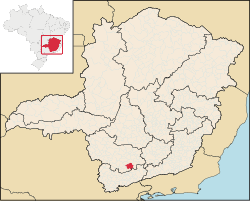Três Corações
| Três Corações | |||
|---|---|---|---|
| City | |||

Três Corações Skyline
|
|||
|
|||
 |
|||
| Location in Brazil | |||
| Coordinates: 21°41′41″S 45°15′19″W / 21.69472°S 45.25528°WCoordinates: 21°41′41″S 45°15′19″W / 21.69472°S 45.25528°W | |||
| Country |
|
||
| Region | Southeast | ||
| State | Minas Gerais | ||
| Mesoregion | South and Southwest of Minas Gerais | ||
| Microregion | Varginha | ||
| Settled | 1760s | ||
| Founded | June 14th, 1832 | ||
| Incorporated | September 23rd, 1884 | ||
| Government | |||
| • Mayor | Claudio Cosme Pereira de Souza | ||
| Area | |||
| • Total | 319.707 sq mi (828.038 km2) | ||
| Elevation | 2,753 ft (839 m) | ||
| Population (2013) | |||
| • Total | 80,000 | ||
| Time zone | BRT (UTC-3) | ||
| • Summer (DST) | BRST (UTC-2) | ||
| Zip Code | 37410-000 | ||
| Area code(s) | 35 | ||
| HDI (2013) | 0.744 | ||
| Website | Official Website | ||
Três Corações (Portuguese: [ˈtɾeʃ koɾaˈsõjʃ], Three Hearts) is a municipality in the south of Minas Gerais state in Brazil. As of 2013, the city population was about 80,000, making it one of the largest cities in the south of Minas Gerais. The city is geographically located close to the circumcenter of the three largest metropolitan areas in Brazil (Belo Horizonte, Rio de Janeiro and São Paulo). Thus, making it a strategic hub for commerce. The city is internationally famous for being the birthplace of the football legend Pelé.
By the year 1760, the Portuguese Tomé Martins da Costa had settled on the banks of the Verde River to explore gold. After some years he built a big farm and started the construction of the "Santíssimos Corações de Jesus, Maria e José" (Joseph, Mary and Jesus's holy hearts) chapel.
In 1764 the Minas Gerais governor, D. Luiz Lobo Diogo Silva, visited Tomé M. Costa and noticed some small houses nearby.
In 1790, Captain Domingos Dias de Barros, Tomé's son in law, built a bigger chapel on the site where the old one stood. It was opened to the public of Três Corações do Rio Verde and the Três Sacratíssimos Corações parish in 1832.
Três Corações do Rio Verde became part of the Minas Gerais Province in 1873, after the President of the province sanctioned laws establishing that the territory was part of its civil parish.
The town continued to develop civically after Emperor D.Pedro II and the imperial family visited it in 1884, for the inaugural of the Minas & Rio railroad. The railroad connected the town to Cruzeiro, a town in the São Paulo Province. Three months following the emperor’s visit, the town was emancipated and became categorized as a city.
...
Wikipedia



